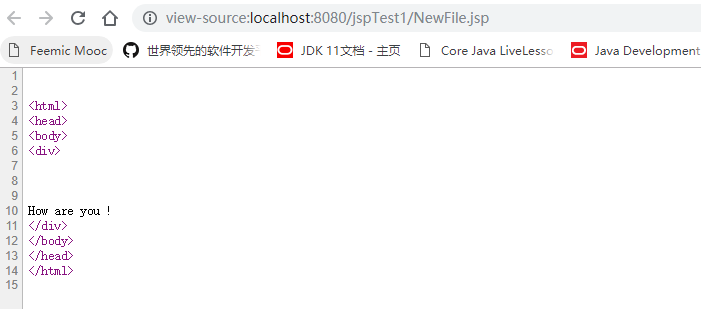动作是第三种类型的语法元素,它们被转换成Java 代码来执行操作,如访问一个Java对象或调用方法。
一. useBean
useBean将创建一个关联Java对象的脚本变量。这 是早期分离的表示层和业务逻辑的手段。随着其他技术 的发展,如自定义标签和表达语言,现在很少使用 useBean方式。
例: 利用useBean给quantity赋值
<jsp:useBean id="quantity" class="java.lang.String" >${quantity="1.25"}</jsp:useBean> <fmt:parseNumber var="formattedNumber" type="number" value="${quantity}"/> ${quantity}

例:
newFile.jsp页面
<%@ page language="java" contentType="text/html; charset=UTF-8" pageEncoding="UTF-8" %> <%@ page import="java.text.DateFormat" %> <%@ page import="java.util.*" %> <!DOCTYPE html> <html> <head> <meta charset="UTF-8"> <title>Insert title here</title> </head> <body> <p></p> <jsp:useBean id="today" class="java.util.Date"/> <%=today%> </body> </html>
在Tomcat中,上述代码被替换成如下代码:
<%-- 部分代码 %--> out.write("<title>Insert title here</title> "); out.write("</head> "); out.write("<body> "); out.write("<p></p> "); java.util.Date today = null; today = (java.util.Date) _jspx_page_context.getAttribute("today", javax.servlet.jsp.PageContext.PAGE_SCOPE); if (today == null){ today = new java.util.Date(); _jspx_page_context.setAttribute("today", today, javax.servlet.jsp.PageContext.PAGE_SCOPE); } out.write(' '); out.write(' '); out.print(today); out.write(" "); out.write("</body> "); out.write("</html>");
输出效果

二. setProperty和getProperty
setProperty动作可对一个Java对象设置属性,而 getProperty则会输出Java对象的一个属性。清单3.11中 的getSetPropertyTest.jsp页面展示如何设置和输出定义 在清单3.10中的Employee类实例的firstName属性。
package main; public class Employee { private String id; private String firstName; private String lastName; public String getId() { return this.id; } public void setId(String id) { this.id = id; } public String getFirstName() { return this.firstName; } public void setFirstName(String firstName) { this.firstName = firstName; } public String getLastName() { return this.lastName; } public void setLastName(String lastName) { this.lastName = lastName; } }
<%@ page language="java" contentType="text/html charset=utf-8" pageEncoding="utf-8" %> <html> <head><title>getProperty</title></head> <body>
<%-- 设置id employee指向的类为main.Employee %--> <jsp:useBean id="employee" class="main.Employee"/>
<%-- 通过java bean 设置调用setFirstName()函数 %--> <jsp:setProperty name="employee" property="firstName" value="Abigail" />
<%--通过java bean 设置调用getFirstName()函数 %-->
First Name: <jsp:getProperty name="employee" property="firstName" /> </body> </html>

四: include
include动作用来动态地引入另一个资源。可以引入 另一个JSP页面,也可以引入一个Servlet或一个静态的 HTML页面 , html代码会叠加............
这里,理解include指令和include动作非常重要。对 于include指令,资源引入发生在页面转换时,即当JSP 容器将页面转换为生成的Servlet时。而对于include动 作,资源引入发生在请求页面时。因此,使用include动 作是可以传递参数的,而include指令不支持。 第二个不同是,include指令对引入的文件扩展名不 做特殊要求。但对于include动作,若引入的文件需以 JSP页面处理,则其文件扩展名必须是JSP。若使用.jspf 为扩展名,则该页面被当作静态文件
<%@ page language="java" contentType="text/html charset=utf-8" pageEncoding="utf-8" %> <html> <head><title>getProperty</title></head> <body> hello; <%-- 首先引入welcome.jsp页面 --%><%-- 然后传递参数text和text值 --%> <jsp:include page="welcome.jsp"> <jsp:param value="How are you !" name="text"/> </jsp:include> </body> </html>
<%@page language="java" contentType="text/html; charset=UTF-8" pageEncoding="UTF-8" %> <%@ page import="java.util.Enumeration" %> <html> <head> <body> <div> <%-- 获取text的值 --%> <% String text= request.getParameter("text"); %> <% out.print(text); %> </div> </body> </head> </html>

五.forward
forward将当前页面转向到其他资源。下面代码将 从当前页转向到welcome.jsp页面:(只会输出welcome一个页面)
<%@ page language="java" contentType="text/html charset=utf-8" pageEncoding="utf-8" %> <html> <head><title>getProperty</title></head> <body> hello; <%-- 首先引入welcome.jsp页面 --%><%-- 然后传递参数text和text值 --%> <jsp:forward page="welcome.jsp"> <jsp:param value="How are you !" name="text"/> </jsp:forward> </body> </html>
<%@page language="java" contentType="text/html; charset=UTF-8" pageEncoding="UTF-8"%> <%@ page import="java.util.Enumeration"%> <html> <head> <body> <div> <%-- 获取text的值 --%> <% String text = request.getParameter("text"); %> <% out.print(text); %> </div> </body> </head> </html>
输出
